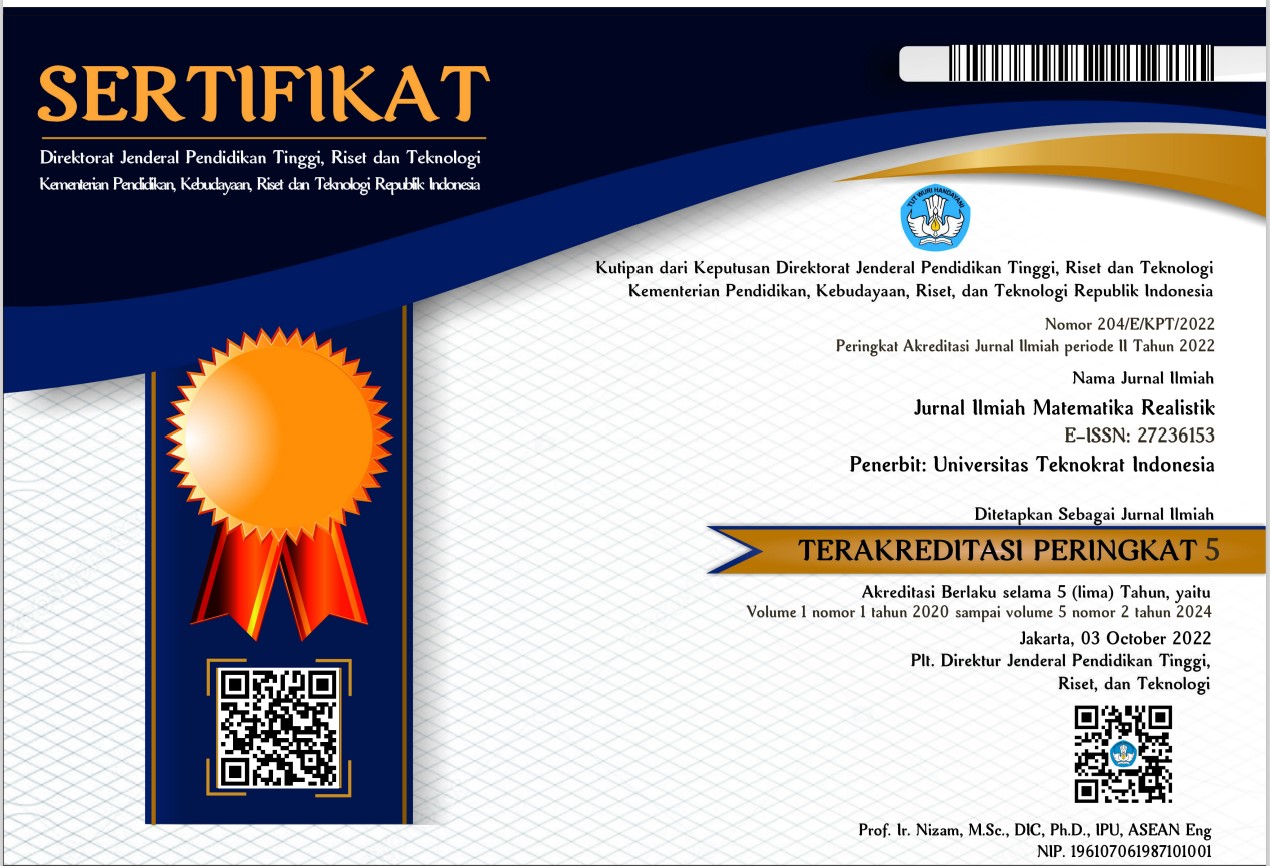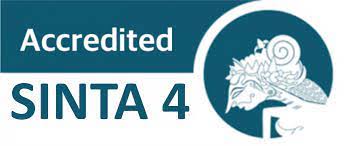PENGEMBANGAN PEMBELAJARAN MATEMATIKA OUTDOOR DENGAN APLIKASI MATCH CITY MAP PADA STOOL TAMAN
Abstract
Penelitian ini bertujuan mengembangkan dan mengevaluasi efektivitas pembelajaran matematika berbasis outdoor learning dengan menggunakan aplikasi Match City Map di lingkungan stool taman Universitas Islam Jember. Model pembelajaran ini mengintegrasikan teknologi berbasis lokasi dengan eksplorasi lingkungan nyata untuk menciptakan pengalaman belajar yang kontekstual, interaktif, dan aplikatif. Metode penelitian menggunakan model Research and Development (R&D) dengan pendekatan ADDIE, melibatkan mahasiswa PGMI Semester VI sebagai subjek penelitian. Aktivitas pembelajaran dirancang untuk mendorong kemampuan pemecahan masalah kompleks melalui pengukuran langsung objek nyata dan pemanfaatan aplikasi digital. Evaluasi dilakukan dengan pretest-posttest dan analisis kuantitatif serta kualitatif melalui observasi, wawancara, dan kuesioner. Hasil penelitian menunjukkan peningkatan signifikan kemampuan pemecahan masalah matematis mahasiswa setelah mengikuti pembelajaran ini. Selain itu, pendekatan ini juga meningkatkan motivasi, keterlibatan, dan keterampilan berpikir kritis mahasiswa. Temuan ini mengindikasikan bahwa integrasi outdoor learning dan teknologi digital berbasis lokasi efektif untuk memperkaya strategi pembelajaran matematika abad ke-21, sekaligus menjembatani kesenjangan antara teori dan praktik dalam konteks pembelajaran kontekstual dan inovatif.
References
Ahsan, M. G. K., & Cahyono, A. N. (2020). Designing augmented reality-based mathematics mobile apps for outdoor mathematics learning. Journal of Physics: Conference …. https://doi.org/10.1088/1742-6596/1567/3/032004
Bacchi, C. (2020). Problem-Solving as a Governing Knowledge: “Skills”-Testing in PISA and PIAAC. Open Journal of Political Science, 10(01), 82–105. https://doi.org/10.4236/ojps.2020.101007
Baharin, N., Kamarudin, N., & Manaf, U. K. A. (2018). Integrating STEM Education Approach in Enhancing Higher Order Thinking Skills. International Journal of Academic Research in Business and Social Sciences, 8(7), 810–821. https://doi.org/10.6007/ijarbss/v8-i7/4421
Bell, N., & Rogoff, B. (1994). Situated Learning: Legitimate Peripheral Participation . Jean Lave, Etienne Wenger. American Ethnologist - AMER ETHNOLOGIST, 21, 918–919. https://doi.org/10.1525/ae.1994.21.4.02a00340
Brečka, P., Valentová, M., & Tureková, I. (2022). Digital Technologies in Environmental Education. TEM Journal, 11(2), 726–730. https://doi.org/10.18421/tem112-28
Cahyono, A. N. (2018). Learning Mathematics in a Mobile App-Supported Math Trail Environment. Springer International Publishing. https://books.google.co.id/books?id=hsRlDwAAQBAJ
Creswell, J. W. (2010). Research design pendekatan kualitatif, kuantitatif, dan mixed. Yogyakarta: Pustaka Pelajar.
Crismono, P. (2023). The Effect of Outdoor Learning on Students’ Attitudes in Mathematics Learning. Jurnal Axioma: Jurnal Matematika Dan Pembelajaran, 8(2).
Crismono, P. C. (2017). Penggunaan Media dan Sumber Belajar dari Alam Sekitar dalam Pembelajaran Matematika. Jurnal Gammath, 2(2), 72–77. http://jurnal.unmuhjember.ac.id/index.php/JPM/article/download/693/564
Crismono, P. C. (2023). Pengaruh Outdoor Mathematich Terhadap Kemampuan Berpikir Tingkat Tinggi (HOTS). FAJAR Jurnal Pendidikan Islam, 3(2), 160–167.
Crismono, P. C. (2024). Metode Penelitian Pendidikan : Pendekatan Kuantitatif, Kualitatif, Ptk, dan Penelitian Pengembangan.
Crismono, P. C., Suryaningrum, C. W., & Jatmikowati, T. E. (2024). Pengaruh model pembelajaran connecting, organizing, reflecting, extending terhadap hasil belajar siswa pada pembelajaran matematika. SIGMA, 9(2), 135–140.
Darus, M. N., Mohd, H., Puteh, N., Marzuki, Z., Baharom, F., Ali Saip, M., Zabidin Husain, M., & Yasin, A. (2015). a Problem Based Learning Model and its Constructivist Framework for IT Courses. Proceedings of the 5th International Conference on Computing and Informatics, ICOCI 2015, 150, 611–617.
Freeman, S., Eddy, S. L., McDonough, M., Smith, M. K., Okoroafor, N., Jordt, H., & Wenderoth, M. P. (2014). Active Learning Increases Student Performance In Science, Engineering, And Mathematics. Proceedings of the National Academy of Sciences of the United States of America, 111(23), 8410–8415. https://doi.org/10.1073/pnas.1319030111
Goebbels, S., & Pohle-Fröhlich, R. (2018). Line-based registration of photogrammetric point clouds with 3D city models by means of mixed integer linear programming. In T. A., I. F., & B. J. (Eds.), VISIGRAPP 2018 - Proceedings of the 13th International Joint Conference on Computer Vision, Imaging and Computer Graphics Theory and Applications (Vol. 4, pp. 299–306). SciTePress. https://doi.org/10.5220/0006533002990306
Haji, S., Sari, W. P., Zamzaili, & Yumiati. (2021). The Impact of an Exploratory Approach in Teaching Mathematics to the Critical Thinking Skills of Junior High School Students. Proceedings of the International Conference on Educational Sciences and Teacher Profession (ICETeP 2020), 532(532), 423–427. https://doi.org/10.2991/assehr.k.210227.071
Jukes, S., & Lynch, J. (2023). Digital technology and environmental pedagogies in tertiary outdoor education: linking digital spaces to more-than-human places. … of Adventure Education and Outdoor Learning. https://doi.org/10.1080/14729679.2023.2230502
Lase, D. (2019). Education and Industrial Revolution 4.0. Jurnal Handayani, 10(1), 48. https://doi.org/10.24114/jh.v10i1.14138
Lee Kim, J., S., & Park, H. (2023). Higher-order thinking in assessments: A comparative study. International Journal of Educational Research, 112, 101–115.
Masruroh, A., Crismono, P. C., & Yanuardianto, E. (2024). Effectiveness of Simulation-Based Serious Games on Numeracy Problem Solving Abilities in Elementary Schools. 11(1).
Nasir, R., Siahaan, U. M. J., & Prafianti, R. A. (2023). Analysis of Mathematical Instruction Barriers in Terms of Developing Students’ Mathematical Reasoning. Vygotsky, 5(1), 65. https://doi.org/10.30736/voj.v5i1.723
NCTM. (2000). Principles and Standards for School Mathematics. Library of Conggress Cataloguing.
Nurin, N. S., Ahsan, M. G. K., & Cahyono, A. N. (2023). Learning mathematical modeling in a virtual mobile math trails environment. AIP Conference Proceedings. https://pubs.aip.org/aip/acp/article/2614/1/040040/2897241
Nurqamar, D., & Nur, I. (2022). Comparative Study of Indonesian Students’ Mathematical Literacy Abilities with Other Countries in Terms of PISA Type HOTS. Eduma : Mathematics Education Learning and Teaching, 11, 45. https://doi.org/10.24235/eduma.v11i1.9924
OCDE. (2023). PISA 2022 Results (Volume I): The State of Learning and Equity in Education. In OECD Publishing (Vol. 46, Issue 183). OECD Publishing. https://doi.org/10.22201/iisue.24486167e.2024.183.61714
Pambudi, D. S. (2022). The Effect of Outdoor Learning Method on Elementary Students’ Motivation and Achievement in Geometry. International Journal of Instruction. https://eric.ed.gov/?id=EJ1331347
Prastyo, A. B., Gembong, S., Masfingatin, T., & Maharani, S. (2020). HOTS Android-Based student worksheets to practice creative thinking ability of vocational school students. In C. B.E.H., I. L., A. D.N., S. E.W., L. M., & R. R. (Eds.), Journal of Physics: Conference Series (Vol. 1464, Issue 1). Institute of Physics Publishing. https://doi.org/10.1088/1742-6596/1464/1/012006
Rafzan, Budimansyah, D., Rahmat, & Fitriasari, S. (2020). Development of Critical Thinking Skills Through the Citizenship Education Course in the Era of Industrial Revolution 4.0. Advances in Social Science, Education and Humanities Research, 418(Acec 2019), 256–261. https://doi.org/10.2991/assehr.k.200320.050
Rosana, D., Widodo, E., Setianingsih, W., & Setyawarno, D. (2020). Developing Assessment Instruments of PISA Model to Measure Students’ Problem-Solving Skills and Scientific Literacy in Junior High Schools. Jurnal Pendidikan Sains Indonesia, 8(2), 292–305. https://doi.org/10.24815/jpsi.v8i2.17468
Seepiwsiw, K., & Seehamongkon, Y. (2023). The Development of Mathematical Problem-Solving and Reasoning Abilities of Sixth Graders by Organizing Learning Activities Using Open Approach. Journal of Education and Learning, 12(4), 42. https://doi.org/10.5539/jel.v12n4p42
Trilling, B., & Fadel, C. (2009). 21st Century Skills: Learning for Life in Our Times. Journal of Sustainable Development Education and Research, 2(1), 243.
Xu, Z., & Qi, C. (2022). Middle school students’ mathematical problem-solving ability and the influencing factors in mainland China. Frontiers in Psychology, 13(November), 1–13. https://doi.org/10.3389/fpsyg.2022.1042315
Young, J. R. (2017). Technology Integration in Mathematics Education: Examining the Quality of Meta-Analytic Research. International Journal on Emerging Mathematics Education, 1(1), 71. https://doi.org/10.12928/ijeme.v1i1.5713
Žakelj, A., Cotič, M., & Doz, D. (2024). Evaluating the impact of active and experiential learning in mathematics: an experimental study on eighth-grade student outcomes. Cogent Education, 11(1), 1–18. https://doi.org/10.1080/2331186X.2024.2436698









